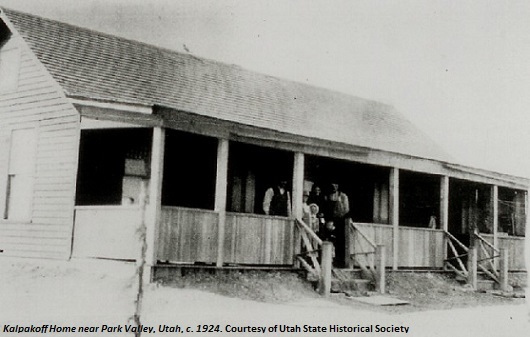Dublin Core
Title
Description
A group of Russian pioneers sought a place to build their religious colony far from cities and government interference. Where else would they come but Utah?
“Invest Dimes and Reap Dollars in Park Valley, Utah!” That was the promise of the Pacific Land & Water Company in its 1911 brochure promoting land for sale northwest of the Great Salt Lake. The Salt Lake company was one of many developers that purchased large tracts of land previously granted to the railroad and then marketed parcels to buyers from out of state. The brochure featured images of orchards, lush fields of grain, and plump sheep and cattle. The pitch was enough to persuade a group of twenty Russian families to purchase several thousand acres in Park Valley and move there in 1914 to create a self-sustaining farming community where they could freely worship.
These families were Molokans, religious dissidents recently exiled from Russia, who had settled in Los Angeles. But California – where civil law reigned – was not the utopia they had imagined. “In fact,” the Box Elder News reported, “it is to get away from American customs that the Russians are coming to [Utah]. [They] object to the check put upon them in California. They object strenuously to their young people adopting American customs … and it is their intention to go to a partly isolated locality, where they will be free to follow customs such as prevail in the land of their birth.”
The Molokans traveled to Kelton, Utah by train and from there by wagon to Dove Creek, where they set about building houses, digging wells, and clearing land for farming. Of course, the dry sagebrush flats of Box Elder County was nothing like the lavish abundance advertised by the Pacific Land & Water Company. Fresh spring green turned quickly to hot summer brown. Despite being experienced farmers, their efforts were unsuccessful.
The last family abandoned Park Valley by 1917, and by 1920 all had returned to Los Angeles. The Molokans left behind their village and a tiny cemetery with graves marked in Russian, along with their dreams of utopia.
Creator
Megan van Frank for Utah Humanities © 2014
Source
Image: Kalpakoff Home near Park Valley, Utah, c. 1924. Once their new homes were completed, the Molokans made every effort to resume normal family and community life. Courtesy of Utah State Historical Society
_______________
See Sarah Yates, “From Dust to Dust: A Russian Sojourn,“ Beehive History 25, Utah Division of State History, 1999, pp 14-17; “Russians Come to Utah for Freedom,” Box Elder News, April 9, 1914, accessed www.digitalnewspapers.org; Marshall E. Bowen, “Russian Colonists in the Utah Desert: Molokan Community in Utah – 1914 to 1918,” paper presented April 10, 2003, at the Association for Arid Lands Studies, Western Social Science Association Conference, Las Vegas, Nevada, accessed http://www.molokane.org/places/USA/Utah/2003_Bowen.html; and a comprehensive bibliography of scholarly articles, news clippings, and resources at http://www.molokane.org/places/USA/Utah/.
Publisher
The Beehive Archive is a production of Utah Humanities. Find sources and the whole collection of past episodes at www.utahhumanities.org
Date
2014-10-17

